



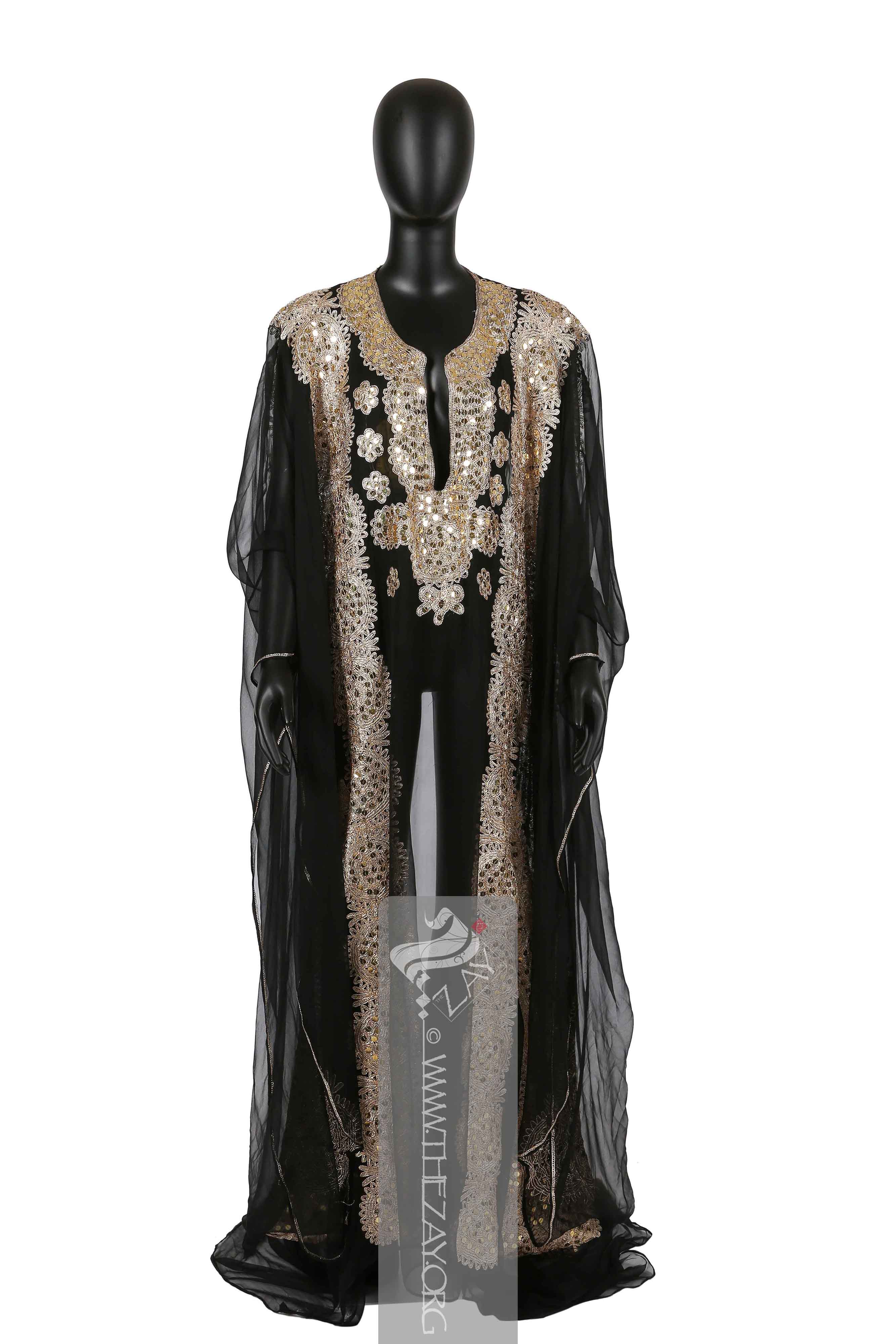
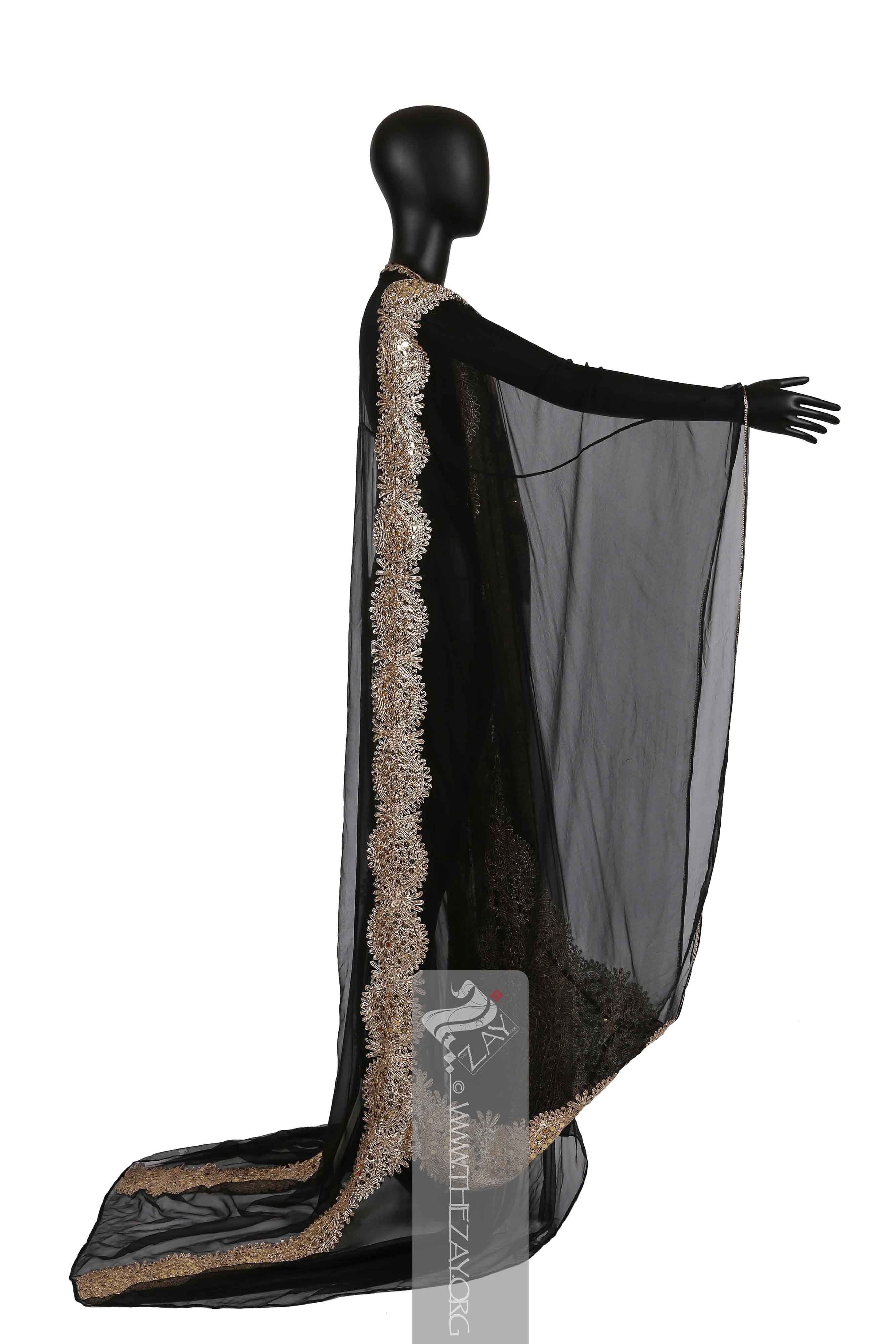
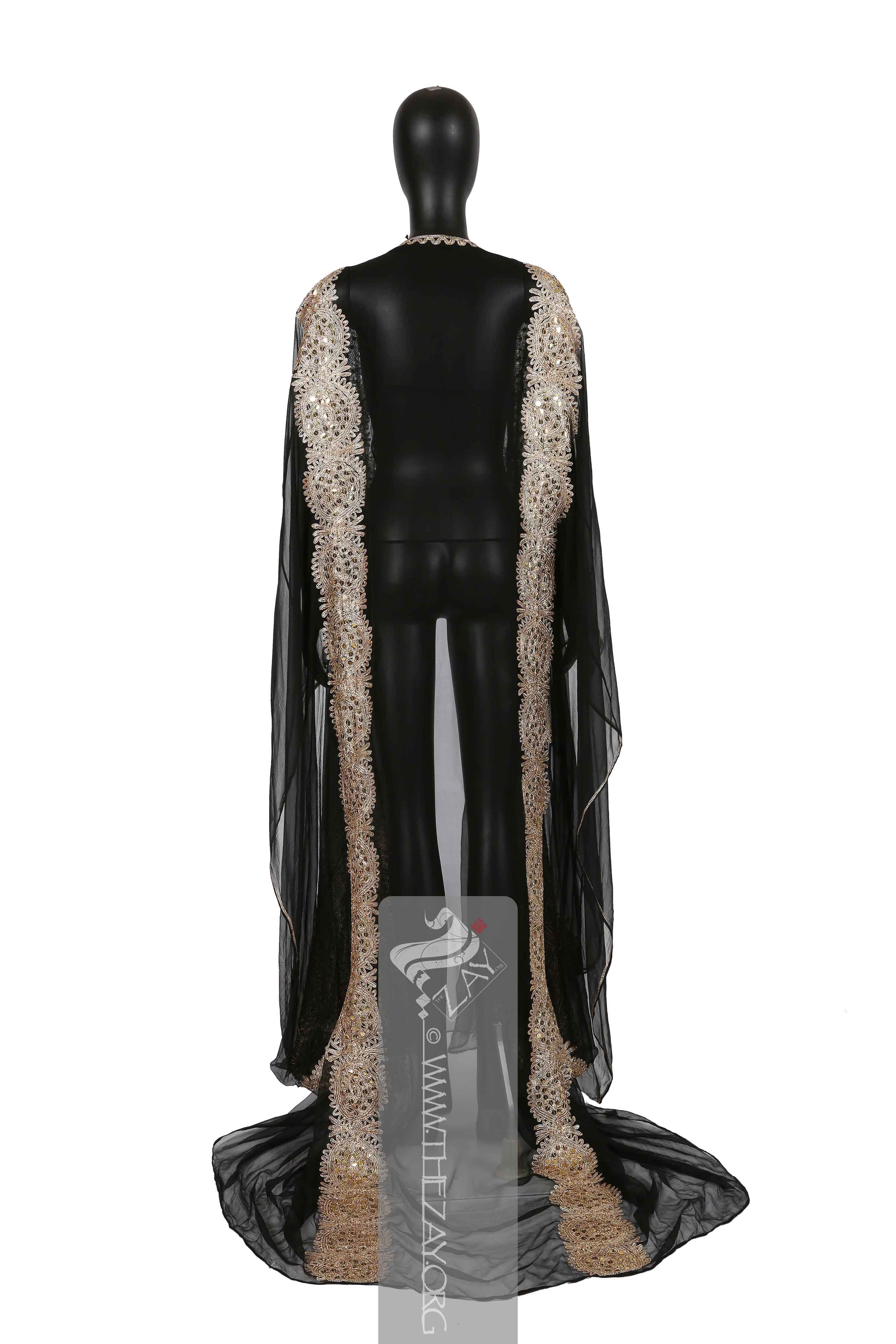

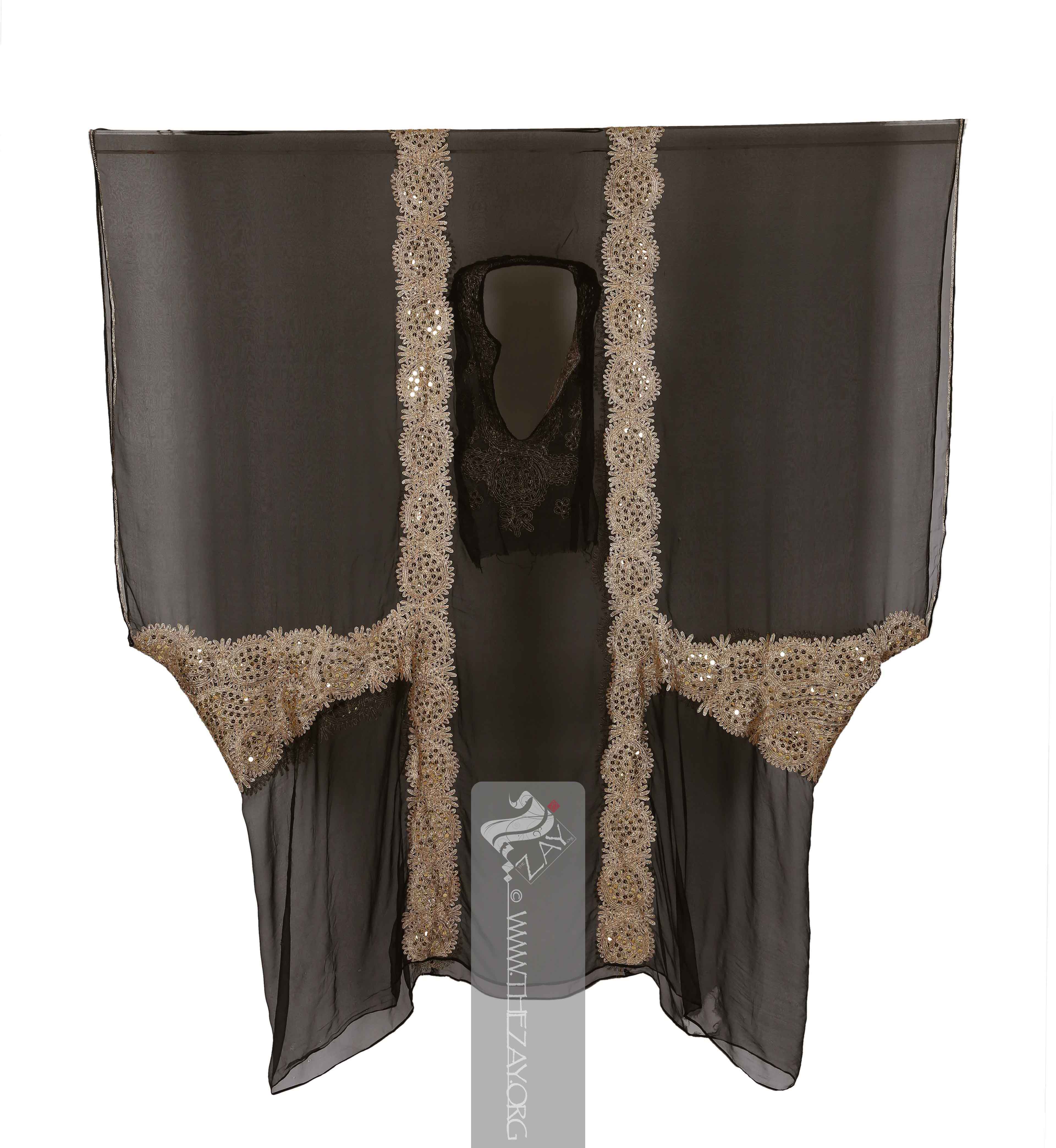

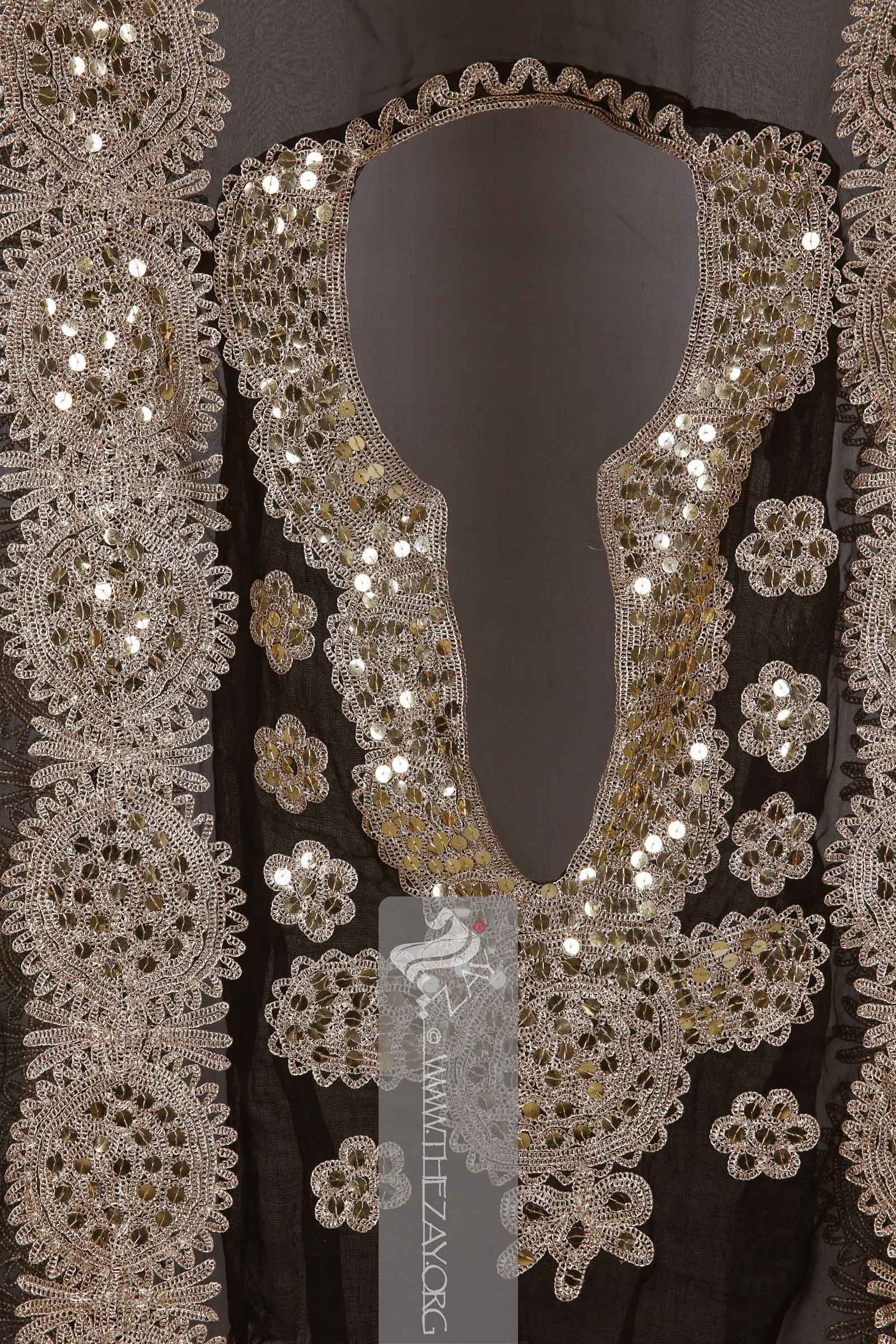

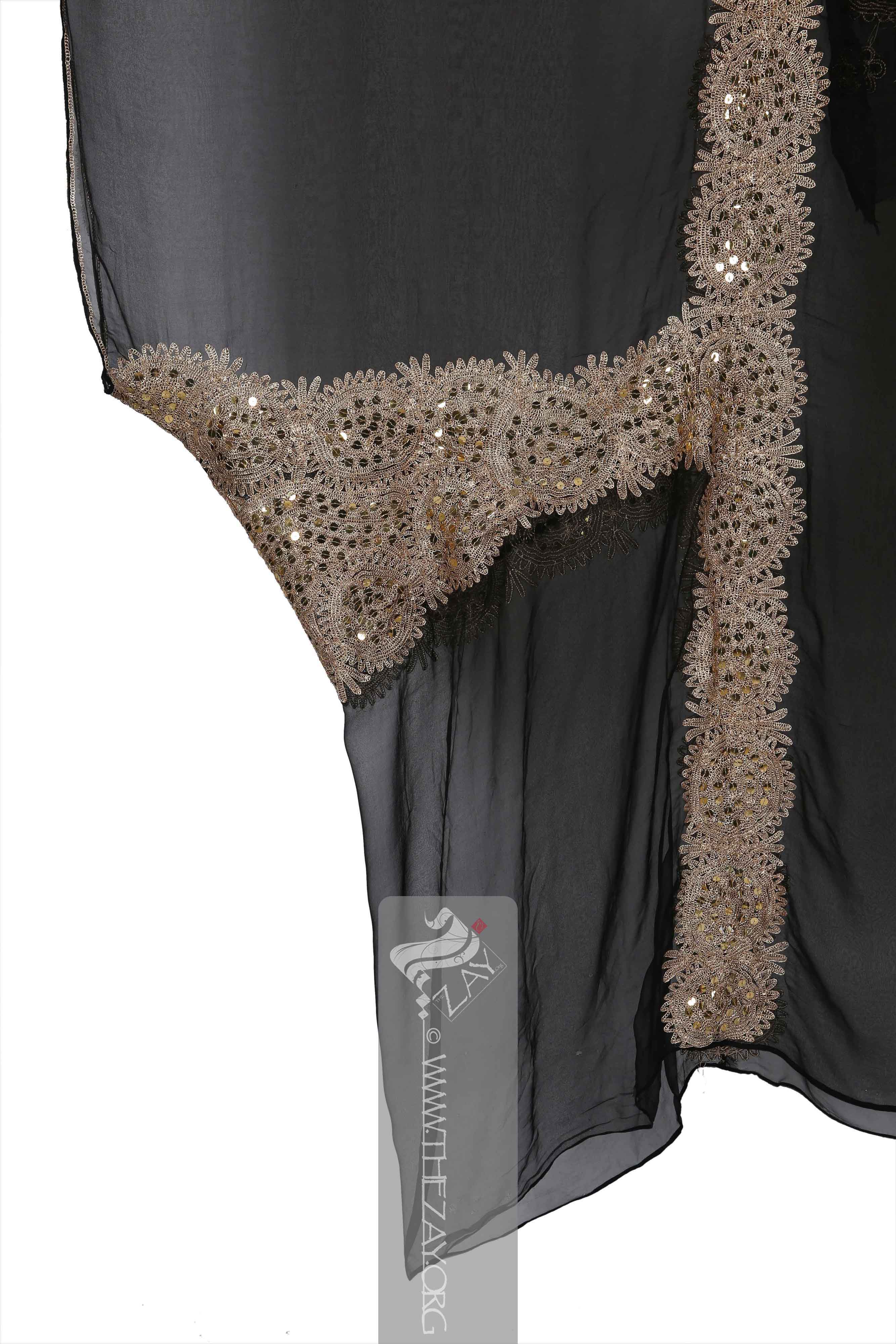
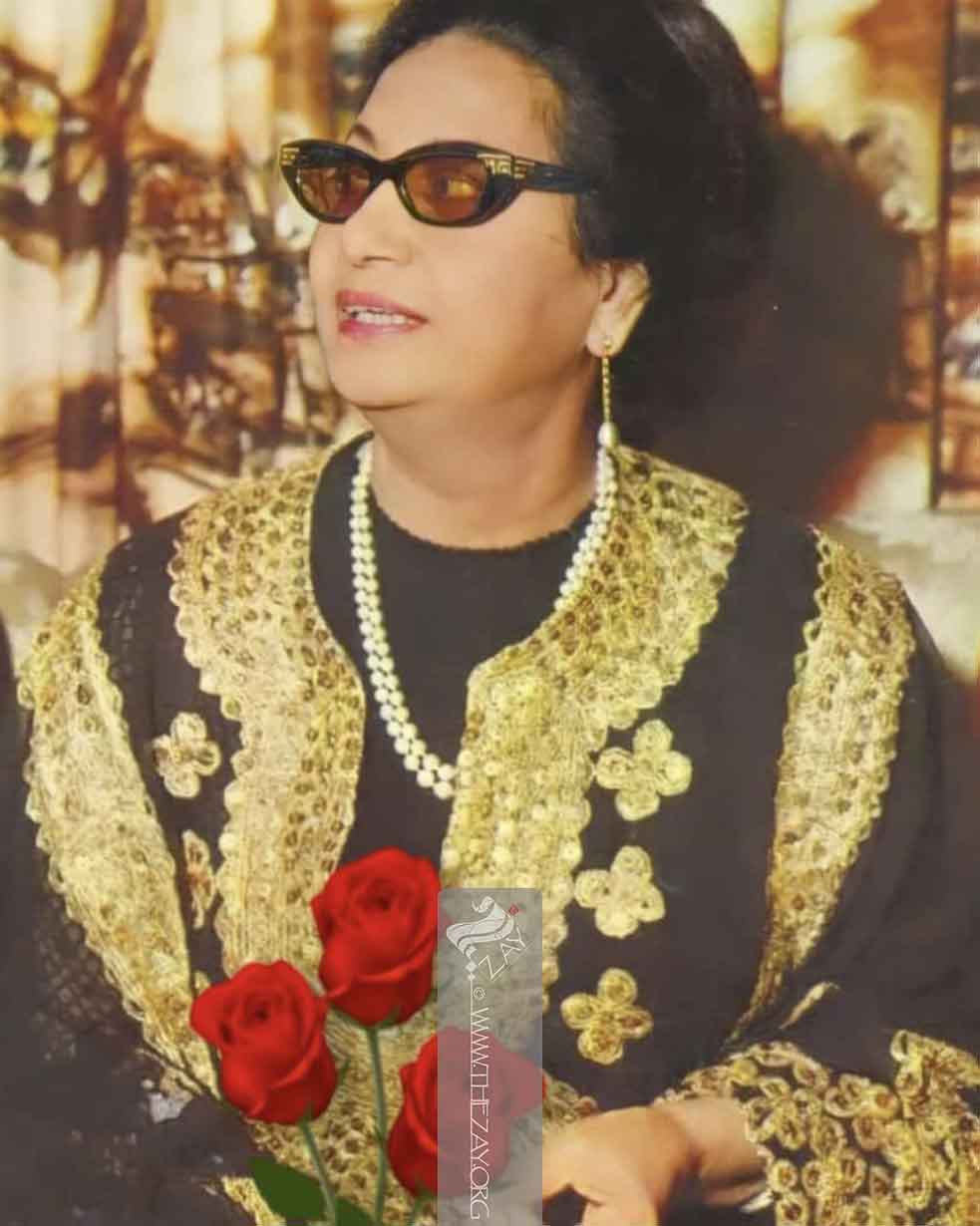


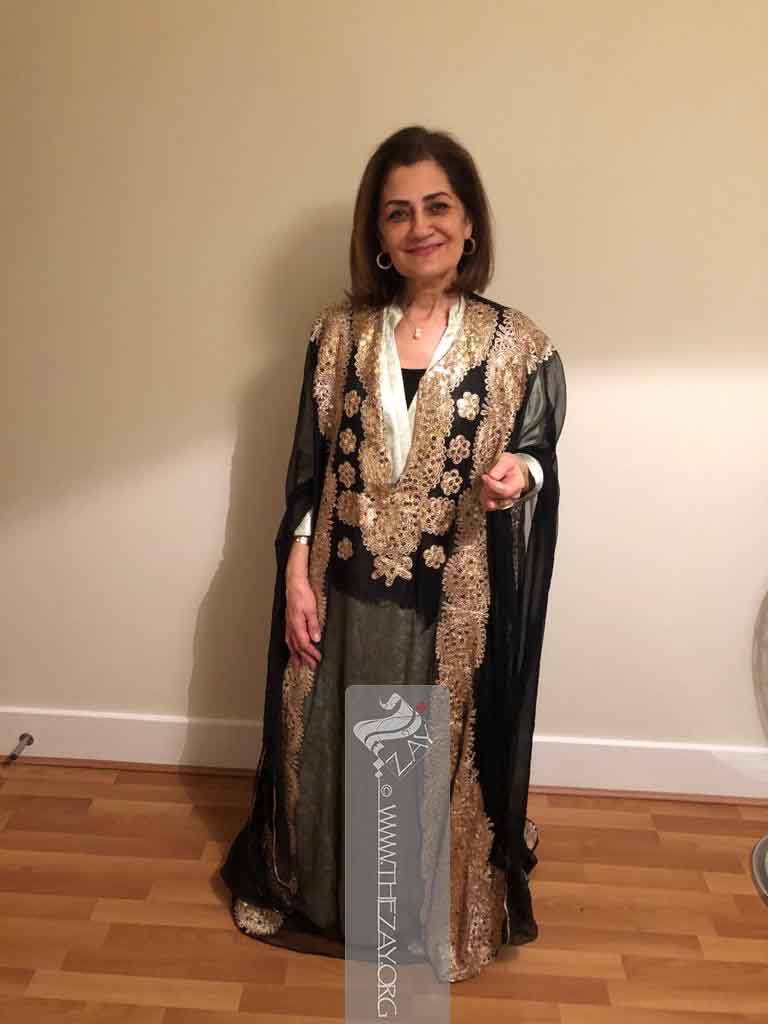
| Local Name | Hashmi, Thawb |
| Object Category | Overgarment |
| Gender | Female |
| Date of object | c. 1941 |
| Place Of orgin | Iraq |
| Region | Basra |
| Object Range | Iraq, Kuwait, Saudi Arabia, Emirates, Qatar, Bahrain |
| Dimensions | Length: 200 cm Width: 172 cm |
| Materials | Silk |
| Technique | Hand Embroidered Machine Stitched |
| Color | |
| Motif | Floral |
| Provenance | Donated, Alya Nawar Al Qaimaqchi, London 2019 |
| Location | The Zay Zay: (Arabic: costume, Pl. azyaā’), a set of clothes in a style typical of a particular country or historical period. Initiative |
| Status | In storage |
| ZI number | ZI2019.500701.1 IRAQ |
Object Note
Part of a lot with another item (ZI2019.500701.2 IRAQ) also in the collection.
Object History
This piece was donated to The Zay Zay: (Arabic: costume, Pl. azyaā’), a set of clothes in a style typical of a particular country or historical period. Initiative by Alya Anwar Al Qaimaqchi on behalf of her mother, who inherited it from her mother and bequeathed it to her daughter and her granddaughter Mariam Istabraq Al Imam in London in 2019.
Originally owned by Atia Abdul Qadir Pasha Al Khudairi, daughter of Abdul Qadir Pasha Al Khudair, who was one of the pivotal players in the establishment of the Iraqi army in 1921.
Hand crafted in Basra to commemorate the momentous occasion of her father’s bravery Atia wore this at his Medal of Honour ceremony, which was bestowed upon him by Miss Gertrude Bell, Oriental Oriental: (Latin and Late Middle English Adjective: orientalis – From Orient; from Latin (noun): oriri – to rise; and oriors – East), anything of an Eastern origin in relationship to Europe – Asia. The word was first used in the context of territorialization between the late 3rd and early 4th Century CE. Secretary, President of the Baghdad Library (later the Iraq National Library) and founder of the Iraq Museum, on behalf of the British government.
The award served as a recognition of his brave efforts in offering refuge within his home to a group of British women seeking protection from Turkish authorities.
Ma’idah is the mother of Alya and grandmother of Mariam, so 4 generations wore this, and Mariam, at the time we got the dress, had just given birth to a daughter, and we hope one day, once she is old enough, we can get her photographed in it as well. We do not have an image of Atia wearing it, but we have Ma’idah, who sadly has passed away this summer in London, Alya & Mariam wearing the same article.
Object Features
This is a traditional Iraqi style woman’s tunic robe (thawb
Thawb: (Arabic: thawb, Pl. Athwāb/thībān), can be pronounced thobe
Thobe: (Arabic: thawb, Pl. Athwāb/thībān), can be pronounced thawb or tobe
Tobe: (Arabic: thawb, Pl. Athwāb/thībān), can be pronounced thawb or thobe based on locale. The standard Arabic word for ‘fabric’ or ‘garment’. It can refer to a qamīs-like tunic worn by men and women in the Arabian Peninsula, Iraq, the southern and south-western ports and islands of Iran, and some countries in East and West Africa. More specifically, it can refer to the square-shaped Bedouin overgarment worn by women. based on locale. The standard Arabic word for ‘fabric’ or ‘garment’. It can also refer to a qamīs-like tunic worn by men and women in the Arabian Peninsula, Iraq, the southern and south-western ports and islands of Iran, and some countries in East and West Africa. More specifically, it can refer to the square-shaped Bedouin overgarment worn by women. or tobe
Tobe: (Arabic: thawb, Pl. Athwāb/thībān), can be pronounced thawb or thobe based on locale. The standard Arabic word for ‘fabric’ or ‘garment’. It can refer to a qamīs-like tunic worn by men and women in the Arabian Peninsula, Iraq, the southern and south-western ports and islands of Iran, and some countries in East and West Africa. More specifically, it can refer to the square-shaped Bedouin overgarment worn by women. based on locale. The standard Arabic word for ‘fabric’ or ‘garment’. It can also refer to a qamīs-like tunic worn by men and women in the Arabian Peninsula, Iraq, the southern and south-western ports and islands of Iran, and some countries in East and West Africa. More specifically, it can refer to the square-shaped Bedouin overgarment worn by women in the Arabian Gulf region. ), often locally referred to as the (hashmi
Hashmī: (Arabic: Hashim (House of) – an Arab royal family from the Banu Hashim clan of the Quraysh tribe), a type of elaborately decorated women’s traditional garment or thawb from Iraq that was named after the royal family that ruled Iraq until the mid 20th century.
The hashmi
Hashmī: (Arabic: Hashim (House of) – an Arab royal family from the Banu Hashim clan of the Quraysh tribe), a type of elaborately decorated women’s traditional garment or thawb from Iraq that was named after the royal family that ruled Iraq until the mid 20th century. Kalabdūn: (Hindustani: kalabattu / kalabattun gold or silver threads; or Dravidian and Sanskrit: pattu or patt – a kind of fine fibre or silk; or Sanskrit: kalavatu – fine material), the gold wire used in embroidery and other embellishments on textiles and fabrics. Pulek: coloquilal Iraqi meaning sequin, in Egyptian and levant dialects it is pronounced (folek), also known by (tirtir). Kalabdūn: (Hindustani: kalabattu / kalabattun gold or silver threads; or Dravidian and Sanskrit: pattu or patt – a kind of fine fibre or silk; or Sanskrit: kalavatu – fine material), the gold wire used in embroidery and other embellishments on textiles and fabrics.
Although the field of the hashmi
Hashmī: (Arabic: Hashim (House of) – an Arab royal family from the Banu Hashim clan of the Quraysh tribe), a type of elaborately decorated women’s traditional garment or thawb from Iraq that was named after the royal family that ruled Iraq until the mid 20th century.
The front (yoke Yoke: (Synonym: Bodice_Yoke), a structured pattern fitted at the shoulders defining the structure of women’s garments. Introduced in c. 1880s it defines the transition between the upper and lower parts of the garments and can now be found stitched-in where the blouse is separated from the skirt by a horizontal seam. ) of the piece has four small floral motifs on either side of the front opening, with the neckline resting over a base of a large roundel with two extended arms on either side.
The underarm gusset of the piece is elaborately and intricately adorned with densely packed roundels and thin bands of linear lines.
While the seamlines along the shoulders are unadorned, the fall hemline and the sleeve edges are trimmed with a thin single line of chain_stitch
Chain_stitch: An embroidery technique where a looped stitch is made in a continuous chain-like pattern. Each stitch is formed by looping the thread through the previous stitch, creating a linked chain. embroidery in gold kalabdun
Kalabdūn: (Hindustani: kalabattu / kalabattun gold or silver threads; or Dravidian and Sanskrit: pattu or patt – a kind of fine fibre or silk; or Sanskrit: kalavatu – fine material), the gold wire used in embroidery and other embellishments on textiles and fabrics. Hashmī: (Arabic: Hashim (House of) – an Arab royal family from the Banu Hashim clan of the Quraysh tribe), a type of elaborately decorated women’s traditional garment or thawb from Iraq that was named after the royal family that ruled Iraq until the mid 20th century.
More details
Although the origin of the hashmi
Hashmī: (Arabic: Hashim (House of) – an Arab royal family from the Banu Hashim clan of the Quraysh tribe), a type of elaborately decorated women’s traditional garment or thawb from Iraq that was named after the royal family that ruled Iraq until the mid 20th century.
Traditionally sewn in Iraq, particularly in Najaf, Hilla, and Basra, it shares a close resemblance to (thawb_najdi
Thawb_Najdī: (Arabic: Najd, Saudi Arabia), referring to the style of overgarment (thawb) worn in Najd. Also known by (mnaykhil), (saḥābī) and (tūr).) and (thawb_nashil
Thawb_nashil: (Arabic : mnshal : cover usedon carriagecarried by camel), in colloquial Gulf dialectthis translates to heavilyadornedovergarments (athwab
Athwāb: (Arabic, sing. thawb), the standard Arabic word for ‘fabric’ or ‘garment’. It can refer to a qamīs-like tunic worn by men and women in the Arabian Peninsula, Iraq, the southern and south-western ports and islands of Iran, and some countries in East and West Africa. More specifically, it can refer to the square-shaped Bedouin overgarment worn by women. It is sometimes spelled (thobe), (thaub), or (tobe
Tobe: (Arabic: thawb, Pl. Athwāb/thībān), can be pronounced thawb or thobe based on locale. The standard Arabic word for ‘fabric’ or ‘garment’. It can refer to a qamīs-like tunic worn by men and women in the Arabian Peninsula, Iraq, the southern and south-western ports and islands of Iran, and some countries in East and West Africa. More specifically, it can refer to the square-shaped Bedouin overgarment worn by women. ).) resembling the heavilyadorned coversof abride’scarriage (hodag). Hashmī: (Arabic: Hashim (House of) – an Arab royal family from the Banu Hashim clan of the Quraysh tribe), a type of elaborately decorated women’s traditional garment or thawb from Iraq that was named after the royal family that ruled Iraq until the mid 20th century.
Often worn with a long dress of a different colour underneath it to accentuate its elegant embroideries, the hashmi
Hashmī: (Arabic: Hashim (House of) – an Arab royal family from the Banu Hashim clan of the Quraysh tribe), a type of elaborately decorated women’s traditional garment or thawb from Iraq that was named after the royal family that ruled Iraq until the mid 20th century.
Links
Charuga: (Possibly Kurdish), a mantle-like embroidered women’s traditional garment from the Qaraqosh region in northern Iraq, traditionally fastened at the shoulder. Historically worn by field workers, it helped conceal dust and dirt, making them less visible during labour, it is a festive garment worn sparingly during festivals and other special occasions.
from Northern Iraq Has Arrived at the TRC!, www.trc-leiden.nl/trc/index.php/en/blog/1378-the-charugaCharuga: (Possibly Kurdish), a mantle-like embroidered women’s traditional garment from the Qaraqosh region in northern Iraq, traditionally fastened at the shoulder. Historically worn by field workers, it helped conceal dust and dirt, making them less visible during labour, it is a festive garment worn sparingly during festivals and other special occasions.
-from-northern-iraq-has-arrvied-at-the-trc. Accessed 29 Jan. 2024.